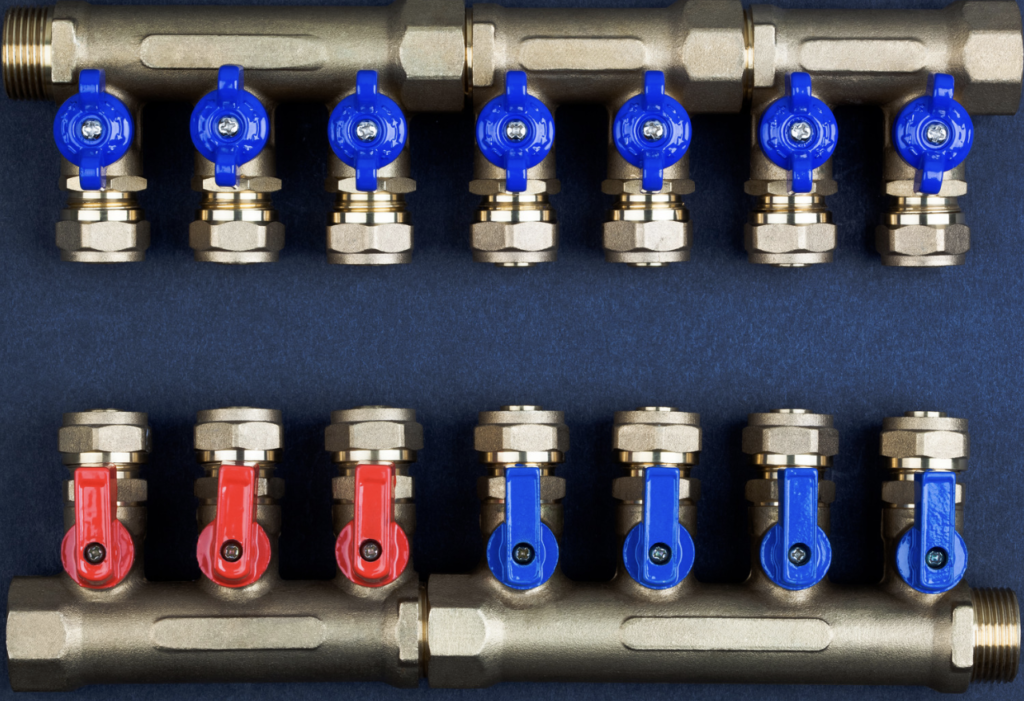Choosing the right plumbing material for your home is essential for ensuring efficiency, durability, and overall performance. Two of the most popular choices in modern plumbing are copper plumbing and PEX plumbing systems. Each offers unique advantages and disadvantages that can impact cost, longevity, installation, and more. This guide explores the pros and cons of copper and PEX, helping you make an informed decision that best suits your home’s needs and your personal preferences.
Understanding Copper and PEX Plumbing
What is Copper Plumbing?
Copper plumbing has been a reliable choice in residential and commercial plumbing systems for decades. Known for its durability, copper is resistant to corrosion, bacteria, and high temperatures, making it an ideal choice for areas that experience extreme weather conditions. Copper pipes are rigid, providing a sturdy system that withstands high pressure and lasts for several decades when properly maintained.
What are PEX Plumbing Systems?
PEX (cross-linked polyethylene) is a flexible plastic tubing that has gained popularity over the past few decades. It’s versatile, cost-effective, and easier to install than traditional copper pipes. PEX plumbing systems are especially popular in residential plumbing because they resist freezing, offer flexibility, and work well in tight spaces.
Pros of Copper Plumbing
1. Exceptional Durability
Copper plumbing is known for its exceptional durability. Resistant to weathering, rust, and UV rays, copper pipes are less likely to degrade over time compared to some other materials. When properly installed and maintained, copper pipes can last up to 70 years, making them a long-term solution.
2. Resilience to Bacteria and Contaminants
Copper is naturally antimicrobial, which helps prevent bacteria buildup inside the pipes. This quality ensures that the water flowing through copper plumbing remains clean and free from harmful microbes, which is especially important for drinking water systems.
3. High Heat Resistance
Copper pipes can withstand high temperatures, making them ideal for hot water systems. They’re also fire-resistant, providing an additional safety measure in case of a fire. This resilience is beneficial in homes that frequently use hot water, as copper maintains its integrity even under extreme temperatures.
4. Eco-Friendly Material
Copper is a recyclable material, making it an environmentally friendly choice. Old or discarded copper pipes can be recycled, reducing waste and the environmental impact of new installations. This recyclability appeals to homeowners seeking sustainable options.
5. Reliable Under High Pressure
Copper plumbing is particularly well-suited for systems that require high water pressure. Its rigid structure allows it to handle intense pressure without flexing or breaking, making it ideal for homes where strong water flow is essential.
Cons of Copper Plumbing
1. Higher Installation Costs
One of the main drawbacks of copper plumbing is its cost. Copper pipes are more expensive than PEX, both in terms of materials and installation labor. The higher cost can be a consideration, especially for large projects or budget-conscious homeowners.
2. Susceptibility to Corrosion in Certain Environments
Although copper is corrosion-resistant, it can still corrode when exposed to acidic water. Homes in areas with acidic or highly mineralized water may experience copper pipe corrosion, leading to leaks and other issues over time. Water treatment or pipe linings may be necessary to prevent corrosion in such cases.
3. Difficulty with Installation in Tight Spaces
Copper pipes are rigid and less flexible than PEX, making them challenging to install in tight or irregularly shaped spaces. Their rigidity often requires additional fittings and connections, which can add to installation time and costs.
4. Vulnerability to Freezing Temperatures
Copper pipes are more prone to freezing and bursting in cold climates compared to PEX plumbing systems. Insulating copper pipes can help mitigate this risk, but it adds to the overall cost of installation and maintenance in colder areas.
Pros of PEX Plumbing Systems
1. Cost-Effective Solution
PEX plumbing systems are more affordable than copper, both in terms of materials and installation. PEX pipes are inexpensive, and their flexibility reduces the need for additional fittings. The affordability of PEX makes it an attractive option for homeowners on a budget or those undertaking large plumbing projects.
2. Flexible and Easy to Install
PEX tubing is highly flexible, which simplifies installation. Unlike copper, which requires precise cuts and joints, PEX can be snaked through walls, floors, and ceilings with ease, requiring fewer connections and reducing the likelihood of leaks. This flexibility makes PEX ideal for remodels, retrofits, and areas with tight access.
3. Resistance to Freezing
PEX pipes are resistant to freezing and bursting, as they can expand and contract with temperature changes. This feature makes PEX plumbing systems particularly beneficial for homes in cold climates. PEX’s freeze-resistance provides peace of mind for homeowners in areas prone to extreme winter conditions.
4. Quiet Operation
Unlike copper pipes, which can produce banging or rattling noises when water flow is stopped abruptly, PEX pipes operate quietly. This sound-dampening property is ideal for homes where noise reduction is a priority, such as those with bedrooms or offices near plumbing lines.
5. Corrosion and Scale Resistance
PEX is highly resistant to corrosion and scale buildup, making it ideal for areas with hard water. Unlike copper, which can be affected by mineral-rich or acidic water, PEX maintains its quality and functionality even in challenging water conditions. This resistance extends the life of the plumbing system and reduces maintenance needs.
Cons of PEX Plumbing Systems
1. Limited UV Resistance
PEX pipes are susceptible to degradation when exposed to UV light. This sensitivity means that PEX plumbing systems must be installed in areas that are shielded from sunlight. Outdoor applications or installations in areas with significant sun exposure are generally not suitable for PEX.
2. Potential Chemical Sensitivity
PEX may absorb chemicals or contaminants if exposed to them, which can impact water quality. Additionally, some water supply systems treat water with chlorine, which can gradually weaken PEX over time. It’s essential to assess the compatibility of PEX with your home’s water supply and treatment methods.
3. Lower Temperature and Pressure Limits
While PEX is resistant to freezing, it has lower temperature and pressure limits compared to copper. This limitation makes it less suitable for systems that require high temperatures, such as those involving direct steam. PEX’s lower temperature tolerance can be a consideration for homeowners with high-heat requirements.
4. Uncertain Long-Term Durability
Although PEX has proven to be durable in residential applications, it hasn’t been in use as long as copper, so its long-term durability is less certain. While PEX systems are expected to last several decades, there isn’t as much historical data on their performance over 50 or more years, as there is with copper.
5. Environmental Concerns
Unlike copper, which is recyclable, PEX is a plastic material that’s challenging to recycle. This aspect can be a drawback for environmentally conscious homeowners who prioritize sustainable building materials.
Comparing Copper and PEX Plumbing Systems
Cost
- Copper: Copper plumbing is more expensive in terms of materials and installation. Its long lifespan may offset this cost over time, but initial expenses are significantly higher.
- PEX: PEX is a budget-friendly option, with low material and installation costs. Its affordability makes it ideal for large projects or homeowners with limited budgets.
Installation
- Copper: Copper’s rigidity makes installation more labor-intensive, especially in tight spaces. The need for soldering and fittings increases installation complexity.
- PEX: PEX is highly flexible and easy to install, even in areas with limited access. Its ease of use reduces installation time and the likelihood of leaks.
Durability
- Copper: Copper is incredibly durable, resistant to high temperatures, and proven to last for decades, especially in stable water conditions.
- PEX: While PEX is durable, it is sensitive to UV light and has a shorter history of use compared to copper. However, it resists corrosion, scaling, and freezing, which can extend its lifespan in certain environments.
Environmental Impact
- Copper: Copper is fully recyclable and has a lower environmental impact in terms of disposal.
- PEX: PEX is not easily recyclable, making it less eco-friendly compared to copper.
Deciding Between Copper and PEX
The choice between copper plumbing and PEX plumbing systems ultimately depends on your specific needs, budget, and environmental considerations. Copper is an excellent choice for those seeking durability, high heat resistance, and long-term reliability. PEX, on the other hand, is ideal for budget-conscious homeowners or those with cold climate needs, thanks to its affordability and resistance to freezing.
Conclusion: Making an Informed Choice
Both copper and PEX plumbing systems offer valuable benefits. Copper provides unmatched durability, heat resistance, and environmental sustainability, while PEX stands out for its flexibility, cost-effectiveness, and ease of installation. By considering your budget, water quality, climate, and plumbing needs, you can select the option that best supports a safe, efficient, and long-lasting plumbing system in your home.
Frequently Asked Questions
1. Which is better for my home, copper or PEX plumbing?
The best choice depends on your specific needs. Copper is durable and heat-resistant, while PEX is cost-effective and flexible, ideal for cold climates.
2. Is PEX plumbing safe for drinking water?
Yes, PEX plumbing is safe for drinking water. However, it’s essential to check compatibility with your local water treatment methods, as some chemicals may affect PEX over time.
3. Does copper plumbing last longer than PEX?
Copper has a proven lifespan of up to 70 years, while PEX is expected to last several decades. Copper’s longer track record makes it more predictable in terms of durability.
4. Can PEX plumbing be used outdoors?
No, PEX is sensitive to UV light, which can degrade it over time. It should only be installed indoors or in areas protected from direct sunlight.
5. Is copper plumbing more environmentally friendly than PEX?
Yes, copper is recyclable, which makes it a more sustainable option compared to PEX, which is challenging to recycle due to its plastic composition.











